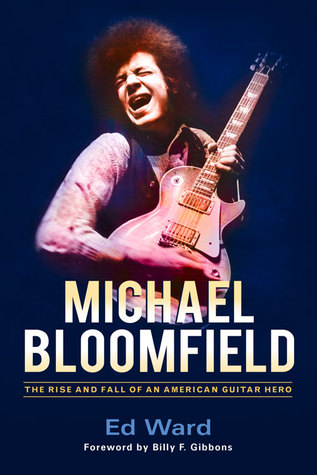 Ed Ward – Michael Bloomfield: The Rise And Fall Of An American Guitar Hero
Ed Ward – Michael Bloomfield: The Rise And Fall Of An American Guitar Hero
272 pages
Anyone who has ever heard the Paul Butterfield Blues Band album East-West undoubtedly has the group’s version of “I Got A Mind To Give Up Living” emblazoned in their memory banks. Butterfield’s vocal gains intensity as he lays out his tale of misery. The lasting power of this performance actually stems from Michael Bloomfield’s searing guitar playing that raises the emotional anguish to near unbearable levels. He demonstrates total mastery of his instrument, spinning out fluid lines, each note a cry for relief from the universal pain that is a part of the human condition.
Born in Chicago, Bloomfield was raised on the north side until his family moved to Glencoe, a northern suburb, where he spent his teenage years. His father ran a successful manufacturing business that his son had little interest in – and Bloomfield did not inherit his father’s athletic skills, deepening the parental divide. An outcast at school, Bloomfield found salvation after he and his brother were given guitars. He learned to play right-handed even though he was naturally left-handed. As author Ed Ward notes, his dominant left hand was used for fingering, giving him extra speed and power to navigate the fret-board. The aspiring musician joined a few bands, got expelled from high school, and banished to a prep school in Massachusetts, where he was introduced to illegal substances.
In the late 1950s, Bloomfield was hanging in blues clubs throughout the city, taking in the sounds of Muddy Waters, Howlin’ Wolf, and Magic Sam. Tired of playing in fraternity bands doing Top 40 songs, he gave up electric guitar at age eighteen to concentrate on playing acoustic folk music. During the three year hiatus, he started listening to the legends of acoustic blues along with other superb pickers like Doc Watson. Another Chicago native, Nick Gravenites, remembered encountering Bloomfield at the Fret Shop, a music store near the University of Chicago. He recalls, “…his fingers flying all over the f**king fret-board, and I was jealous…..a smart-ass Jewish punk from the North Side…It was just that he was so talented, it pissed you off.”
Ward’s biography was first published in 1983 with a very limited release. The new edition adds a wealth of material, including a candid 1968 interview with Rolling Stone magazine. The author traces Bloomfield’s development in the rough & tumble Chicago clubs, his tenure booking blues shows at the Fickle Pickle including Big Joe Williams, and then the switch to Big John’s club on North Wells St., opening with Big Joe, Bloomfield, and Charlie Musselwhite. Once Bloomfield hooks up with Butterfield, the band captivates audiences with the harp player’s tough swagger and Bloomfield’s undeniable talent. Their records on the Electra label spark interest from a new generation of blues fans who welcomed the group’s high energy and hard edge.
As the band started touring, Bloomfield’s influence spread as other musicians were able to experience him live. Soon one of the biggest names at that time came calling. Bob Dylan wanted Bloomfield to back him on guitar for sessions for the Highway 61 Revisited project. With the Butterfield Band, Bloomfield participated in one of the acknowledged watershed moments in music history, as they plugged-in to back Dylan at the 1965 Newport Folk Festival, a point that marked the decline of the folk music boom as well as elevating Bloomfield’s stature.
Along with the fame came the realization that Bloomfield hated to be living life on the road. The long stretches away from home lead to increased drug and alcohol consumption. Blessed with a photographic memory and a deep love of music, he had little regard for fame or money. His Super Session record with Al Kooper brought more attention but an inability to sleep combined with his other issues left Bloomfield in a downward spiral that eventually claimed his life in 1981 at the age of thirty-seven.
Using interviews with family, friends, and musicians, Ward lays out a compelling chronicle of Bloomfield’s life and influence. He covers the later years when the guitar player recorded a number of albums for small labels featuring his acoustic playing on guitar and piano. Also included in an extensive fifty-eight page discography plus twenty-two pages of B/W and color photos.
In an interview with the author, the guitarist delivers a fitting self-assessment, “As long as I mature as an artist, my life is not in vain…..I’ve influenced millions of musicians….I am not going to work to become an idol again. That is not what I am shooting for, because I am sure that the price you pay for that, with my personality, would be too great of a price. I used to be a very crazy guy, and I had pain for almost every day for years…..It never stopped….really lost your mind to the degree that you hurt every day….so that you would do anything to stop it. I think I know the sonorities and the melodies and the chords that are really beautiful….Oh, if I could only do just one that would make me as proud as…I was with the first Butterfield album.
Ward certainly makes a heartfelt case for Bloomfield’s status as a guitar hero in this excellent biography of a troubled soul who used his guitar in an attempt to ease his pain – and, in doing so, gave the world some truly remarkable music.

